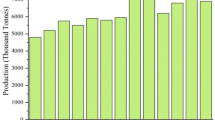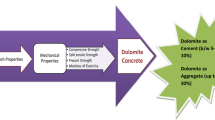Abstract
The present study focuses on utilizing stockpiled dolomite quarry waste for sustainable and cleaner production of concrete. Natural river sand is substituted with dolomite quarry waste at 0, 10, 20, 30, 40, 50, 60, 70, 80, 90, and 100% in concrete mixes. The test findings revealed the concrete mix made with 10% dolomite quarry waste displayed mechanical strength comparable to the control concrete mix. The concrete compressive strength and elastic modulus decreased slightly by 3.30% and 2.40%, respectively, at the 10% substitution of natural river sand. A mathematical model for predicting the compressive strength, elastic modulus, and other properties of concrete was also developed in the study. Water absorption, sorptivity coefficient, and carbonation depth increased by 2.90%, 4.16%, and 5.80%, respectively, and ultrasonic pulse velocity and surface resistivity of concrete decreased by 0.76% and 6.25%, respectively, using 10% dolomite quarry waste. Modified concrete containing dolomite quarry waste at all replacement levels showed improved resistance in the sulphuric acid attack. Furthermore, the study’s overall outcomes revealed that dolomite quarry waste had a good sustainability performance with a lower environmental impact than conventional concrete.




















Similar content being viewed by others
References
Peduzzi P (2014) Sand, rarer than one thinks. Article reproduced from United Nations Environment Programme (UNEP) Global Environmental Alert Service (GEAS). Environ Dev 11:208–218
Gupta T, Siddique S, Sharma RK, Chaudhary S (2019) Behaviour of waste rubber powder and hybrid rubber concrete in aggressive environment. Constr Build Mater 217:283–291. https://doi.org/10.1016/j.conbuildmat.2019.05.080
Agrawal Y, Siddique S, Sharma RK, Gupta T (2021) Valorization of granite production dust in development of rich and lean cement mortar. J Mater Cycles Waste Manage 23(2):686–698. https://doi.org/10.1007/s10163-020-01158-4
Kabeer KISA, Vyas AK (2018) Utilization of marble powder as fine aggregate in mortar mixes. Constr Build Mater 165:321–332. https://doi.org/10.1016/j.conbuildmat.2018.01.061
Siddique S, Chaudhary S, Shrivastava S, Gupta T (2019) Sustainable utilisation of ceramic waste in concrete: exposure to adverse conditions. J Clean Prod 210:246–255. https://doi.org/10.1016/j.jclepro.2018.10.231
Mundra S, Agrawal V, Nagar R (2020) Sandstone cutting waste as partial replacement of fine aggregates in concrete: a mechanical strength perspective. J Build Eng 32:1–11. https://doi.org/10.1016/j.jobe.2020.101534
Omar OM, Abd Elhameed GD, Sherif MA, Mohamadien HA (2012) Influence of limestone waste as partial replacement material for sand and marble powder in concrete properties. HBRC J 8(3):193–203. https://doi.org/10.1016/j.hbrcj.2012.10.005
Rafieizonooz M, Mirza J, Salim MR et al (2016) Investigation of coal bottom ash and fly ash in concrete as replacement for sand and cement. Constr Build Mater 116:15–24. https://doi.org/10.1016/j.conbuildmat.2016.04.080
Indian Minerals Yearbook-2019 (2020) Ministry of Mines Indian Bureau of Mines. Nagpur, India. https://ibm.gov.in/writereaddata/files/04042020120509Dolomite_19_AR.pdf (ibm.gov.in)
García E, Alfonso P, Labrador M, Galí S (2003) Dedolomitization in different alkaline media: application to Portland cement paste. Cem Concr Res 33(9):1443–1448. https://doi.org/10.1016/S0008-8846(03)00095-4
Isa NF, Muhamad K, Yahya N et al (2016) Dolomite quarry waste as sand replacement in sand brick. In: Materials science forum, vol 857. Trans Tech Publications Ltd, pp 319–322
Agrawal Y, Gupta T, Siddique S, Sharma RK (2021) Potential of dolomite industrial waste as construction material: a review. Innov Infrastruct Sol 6(4):1–15. https://doi.org/10.1007/s41062-021-00570-5
Donza H, Cabrera O, Irassar EF (2002) High-strength concrete with different fine aggregate. Cem Concr Res 32(11):1755–1761. https://doi.org/10.1016/S0008-8846(02)00860-8
Saranya P, Nagarajan P, Shashikala AP (2019) Development of ground-granulated blast-furnace slag-dolomite geopolymer concrete. ACI Mater J 11(6). https://doi.org/10.14359/51716981
Barbhuiya S (2011) Effects of fly ash and dolomite powder on the properties of self-compacting concrete. Constr Build Mater 25(8):3301–3305. https://doi.org/10.1016/j.conbuildmat.2011.03.018
Mikhailova O, Yakovlev G, Maeva I, Senkov S (2013) Effect of dolomite limestone powder on the compressive strength of concrete. Proc Eng 57:775–780
Jauffret G, Glasser FP (2016) Thermally activated dolomite as pozzolanic addition to Portland cement. Adv Cem Res 28(6):378–388. https://doi.org/10.1680/jadcr.15.00110
Chen Z, Deng M, Liu P (2020) Application of light-burnt dolomite as a mineral addition in concrete. Adv Cem Res. https://doi.org/10.1680/jadcr.18.00206
Aral İF, Cihan MT (2019) Investigation of properties of mortars containing waste stone powder instead of sand under freezing-thawing effect. In: IOP conference series: earth and environmental science, vol 362(1), p 012169
Manikandan P, Dhivya S, Poornima S et al (2021) Effect of fine aggregate replacement with dolomite powder on GFRC mechanical properties. IOP Conf Ser Mater Sci Eng 1145(1):012083. https://doi.org/10.1088/1757-899x/1145/1/012083
Landu TMA, Prakash C et al (2021) Dolomite rock sand as fine aggregate replacement in construction activities: a comparative study. Mater Today Proc. https://doi.org/10.1016/j.matpr.2020.10.678
Pyo S, Kim HK, Lee BY (2017) Effects of coarser fine aggregate on tensile properties of ultra high performance concrete. Cem Concr Compos 84:28–35. https://doi.org/10.1016/j.cemconcomp.2017.08.014
Gupta T, Patel KA, Siddique S et al (2019) Prediction of mechanical properties of rubberised concrete exposed to elevated temperature using ANN. Meas J Int Meas Confed. https://doi.org/10.1016/j.measurement.2019.106870
Gupta T, Siddique S, Sharma RK, Chaudhary S (2020) Effect of aggressive environment on durability of concrete containing fibrous rubber shreds and silica fume. Struct Concr 147:106870. https://doi.org/10.1002/suco.202000043
Gupta T, Chaudhary S, Sharma RK (2016) Mechanical and durability properties of waste rubber fiber concrete with and without silica fume. J Clean Prod 112:702–711. https://doi.org/10.1016/j.jclepro.2015.07.081
Chouhan DS, Agrawal Y, Gupta T, Sharma RK (2017) Utilization of granite slurry waste in concrete: a review. Indian J Sci Technol 10(6):1–9. https://doi.org/10.17485/ijst/2017/v10i6/88279
BIS: 8112-1989 (2013) Specification for 43 grade ordinary Portland cement. Bureau of Indian Standards, New Delhi, India
BIS: 383 (2016) Coarse and fine aggregate for concrete—specification. Bureau of Indian Standards, New Delhi, India
BIS: 10262 (2009) Indian standard guidelines for concrete mix design proportioning. Bureau of Indian Standards, New Delhi, India
BIS: 1199 (2004) Indian standard methods of sampling and analysis of concrete. Bureau of Indian Standards, New Delhi, India
BIS: 516-1959 (2004) Indian standard methods of tests for strength of concrete. Bureau of Indian Standards, New Delhi, India
ASTM C469 (2014) Standard test method for static modulus of elasticity and Poisson’s ratio of concrete in compression. ASTM Int
ASTM C642-13 (2013) Standard test method for density, absorption, and voids in hardened concrete. ASTM International
ASTM C1585-13 (2013) Standard test method for measurement of rate of absorption of water by hydraulic cement concretes. ASTM Int
BIS: 13311 (Part 1) (1992) Method of non-destructive testing of concrete, part 1: ultrasonic pulse velocity. Bureau of Indian Standards, New Delhi, India
AASHTO T358 (2013) Standard method of test for surface resistivity indication of concrete’s ability to resist chloride ion penetration. Am Assoc State Highw Transp Off
ASTM C267 (2015) Standard test methods for chemical resistance of mortars, grouts, and monolithic surfacings and polymer concretes
RILEM T (1994) CPC-18 measurement of hardened concrete carbonation depth. RILEM Recomm Test Use Constr Mater
Gupta T, Kothari S, Siddique S et al (2019) Influence of stone processing dust on mechanical, durability and sustainability of concrete. Constr Build Mater 223:918–927. https://doi.org/10.1016/j.conbuildmat.2019.07.188
Jelčić Rukavina M (2015) Modifications of dolomite-based self-compacting concrete properties using mineral additives. Teh Vjesn Tech Gaz 22(1):233–240. https://doi.org/10.17559/tv-20140327212200
ACI Committee 209 (2005) Report on factors affecting Shrinkage and creep of hardened concrete. Am Concr Inst
Prokof’Ev VY, Zakharov ON, Razgovorov PB (2009) Physical-chemical phenomena occurring during the production of sorbent from a clay-dolomite composition. Glas Ceram 66(3–4):147–150. https://doi.org/10.1007/s10717-009-9132-8
Meddah MS, Lmbachiya MC, Dhir RK (2014) Potential use of binary and composite limestone cements in concrete production. Constr Build Mater 58:193–205. https://doi.org/10.1016/j.conbuildmat.2013.12.012
BIS:456 (2000) Indian standard plain and reinforced concrete—code of practice. Bureau of Indian Standards, New Delhi, India
ACI Committee 318 (2014) Building code requirements for structural concrete. Am Concr Inst
Neville AM (1996) Properties of concrete, 4th edn. Person Education Press, London
Rana A, Kalla P, Csetenyi LJ (2015) Sustainable use of marble slurry in concrete. J Clean Prod 94:304–311. https://doi.org/10.1016/j.jclepro.2015.01.053
Ganesh Prabhu G, Hyun JH, Kim YY (2014) Effects of foundry sand as a fine aggregate in concrete production. Constr Build Mater 70:514–521. https://doi.org/10.1016/j.conbuildmat.2014.07.070
Goueygou M, Abraham O, Lataste JF (2008) A comparative study of two non-destructive testing methods to assess near-surface mechanical damage in concrete structures. NDT E Int 41(6):448–456. https://doi.org/10.1016/j.ndteint.2008.03.001
Azarsa P, Gupta R (2017) Electrical resistivity of concrete for durability evaluation: a review. Adv Mater Sci Eng 2017:1–30
Miranda P, Seal T (2008) MLA: current projects at the center for advanced mineral and metallurgical processing. In: Hydrometallurgy 2008: proceedings of the 6th international symposium
Siddique S, Shrivastava S, Chaudhary S (2018) Evaluating resistance of fine bone china ceramic aggregate concrete to sulphate attack. Constr Build Mater 186:826–832. https://doi.org/10.1016/j.conbuildmat.2018.07.138
Siddique S, Gupta T, Thakare AA et al (2019) Acid resistance of fine bone china ceramic aggregate concrete. Eur J Environ Civ Eng 25(7):1219–1232
Al-Swaidani A, Soud A, Hammami A (2017) Improvement of the early-age compressive strength, water permeability, and sulfuric acid resistance of scoria-based mortars/concrete using limestone filler. Adv Mater Sci Eng 2017:1–17. https://doi.org/10.1155/2017/8373518
Redaelli E, Bertolini L (2016) Resistance to carbonation of concrete after re-alkalization by absorption of sodium carbonate solution. Stud Conserv 61(5):297–305. https://doi.org/10.1179/2047058415Y.0000000011
Possan E, Thomaz WA, Aleandri GA et al (2017) CO2 uptake potential due to concrete carbonation: a case study. Case Stud Constr Mater 6:147–161. https://doi.org/10.1016/j.cscm.2017.01.007
Litfi M, Zafar I (2019) Effect of total substitution of crushed limestone sand on concrete durability. Eur J Environ Civ Eng. https://doi.org/10.1080/19648189.2019.1649199
Gallucci K, Stendardo S, Foscolo PU (2008) CO2 capture by means of dolomite in hydrogen production from syn gas. Int J Hydrogen Energy 33(12):3049–3055. https://doi.org/10.1016/j.ijhydene.2008.03.039
Author information
Authors and Affiliations
Corresponding author
Additional information
Publisher's Note
Springer Nature remains neutral with regard to jurisdictional claims in published maps and institutional affiliations.
Rights and permissions
About this article
Cite this article
Agrawal, Y., Gupta, T. & Sharma, R.K. Strength and durability assessment of concrete containing dolomite quarry waste as fine aggregate. J Mater Cycles Waste Manag 24, 268–286 (2022). https://doi.org/10.1007/s10163-021-01318-0
Received:
Accepted:
Published:
Issue Date:
DOI: https://doi.org/10.1007/s10163-021-01318-0




